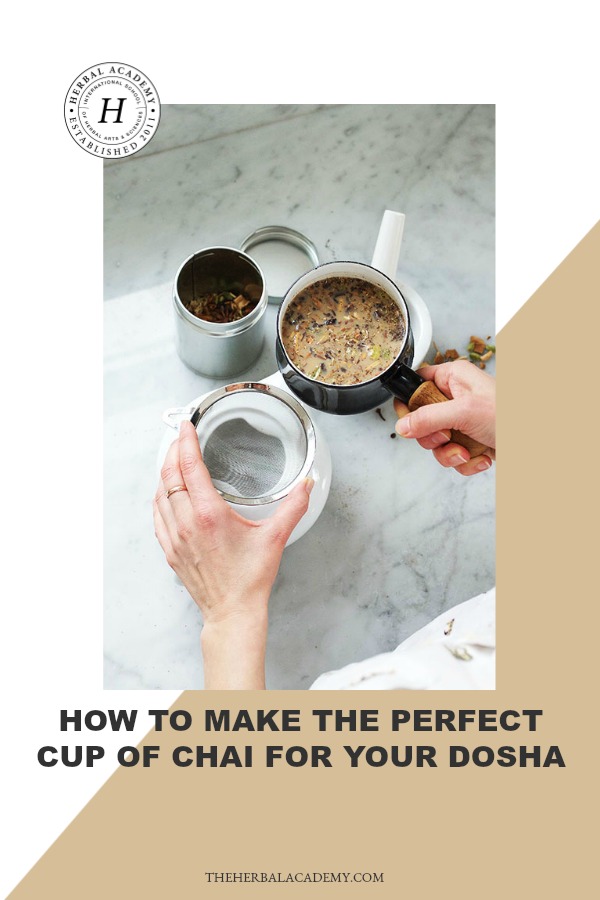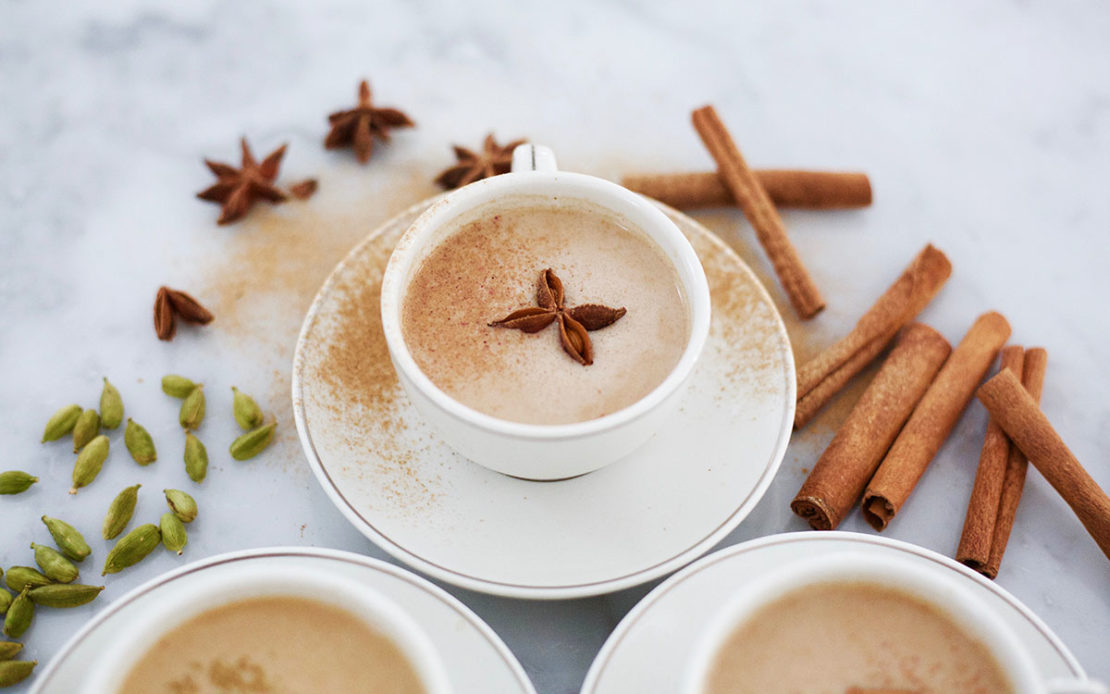
How to Make the Perfect Cup of Chai for Your Dosha
Forget bright copper kettles and warm woolen mittens—chai is one of my favorite things. For me, a great cup of chai is right up there with puppies, autumn leaves, and twinkling Christmas lights. I don’t know if it’s the perfect blend of sweet, warming spices, the creaminess of the milk, or the happy caffeine buzz that follows, but a well-made cup of chai can definitely improve my outlook on the day. Ever since I visited South India in 2011, I have been making chai at home, seeking out that ginger-infused perfection that I encountered in India. I can’t say that I could make it as a street chai wallah yet, but I have learned a few things about chai over the years. Hopefully, the recipes and tips you find in this article will not only inspire you to make the perfect cup of chai but will teach you how to tune your chai recipe to your Ayurvedic dosha as well.
If you are a novice to Ayurveda and the concept of doshas, you may want to read my Introduction to Ayurveda blog post on the Herbal Academy blog first.
To begin, let’s cover the basic chai ingredients and their health benefits. You see, chai isn’t all taste and no substance. Each of the ingredients that goes into making a perfect cup of chai has its own nutritional benefits. Also, as you will see, by understanding the energetics of the various spices, you can make choices about what to emphasize or downplay to find the perfect cup of chai for your dosha.
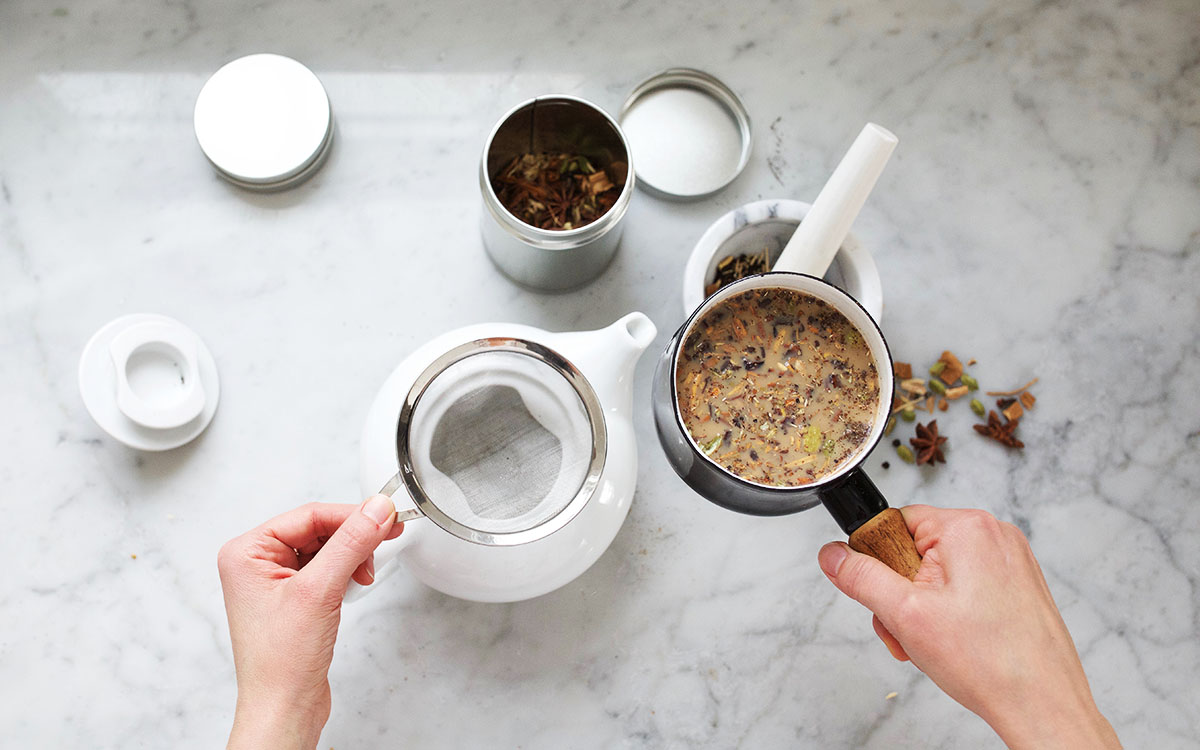
Basic Chai Ingredients
Black Tea (Camellia sinensis)
Black tea is heating and stimulating, and some people find that they are better off avoiding caffeine entirely as it is simply too drying and agitating for them. However, the milk, spices, and sweetener in chai help balance some of the intensity of the black tea. Furthermore, tea certainly has many positive attributes. Tea varieties including green, black, and white tea are rich in antioxidants and other phytochemical, and possess the astringent and bitter tastes that are lacking in many American diets (Palanisamy, 2015). Black tea is a very good choice for kapha types, who tend to need a little stimulation to help them get up and go.
Ginger (Zingiberis officinale)
Ginger has a spicy, sweet taste and a heating energy. It decreases vata and kapha doshas and increases pitta dosha. Ginger increases agni (the digestive fire), partially by stimulating the secretion of digestive enzymes (Pole, 2013). It also increases the rate of gut motility, meaning that it helps food move in a more timely manner through the digestive tract. Ginger is also a powerful anti-inflammatory and helps to dissolve ama, a word for toxins in Ayurveda (Palanisamy, 2015).
Cardamom (Eletarria cardamomum)
With its bright, mildly sweet, warm flavor, cardamom is probably my favorite spice on this list, and no cup of chai is complete without cardamom. Cardamom has a slightly warm quality, but it is not as heating as some of the other spices, so it will not aggravate pitta as long as it is not used excessively. In fact, cardamom stimulates agni without aggravating pitta. It also has a clearing effect on the mind and helps regulate the energetic flow of vata in a healthy downwards direction (Pole, 2013). Also, cardamom has a special role as an ingredient in chai because it helps support digestion of dairy and mitigates the vata-provoking effects of black tea (Dass, 2013).
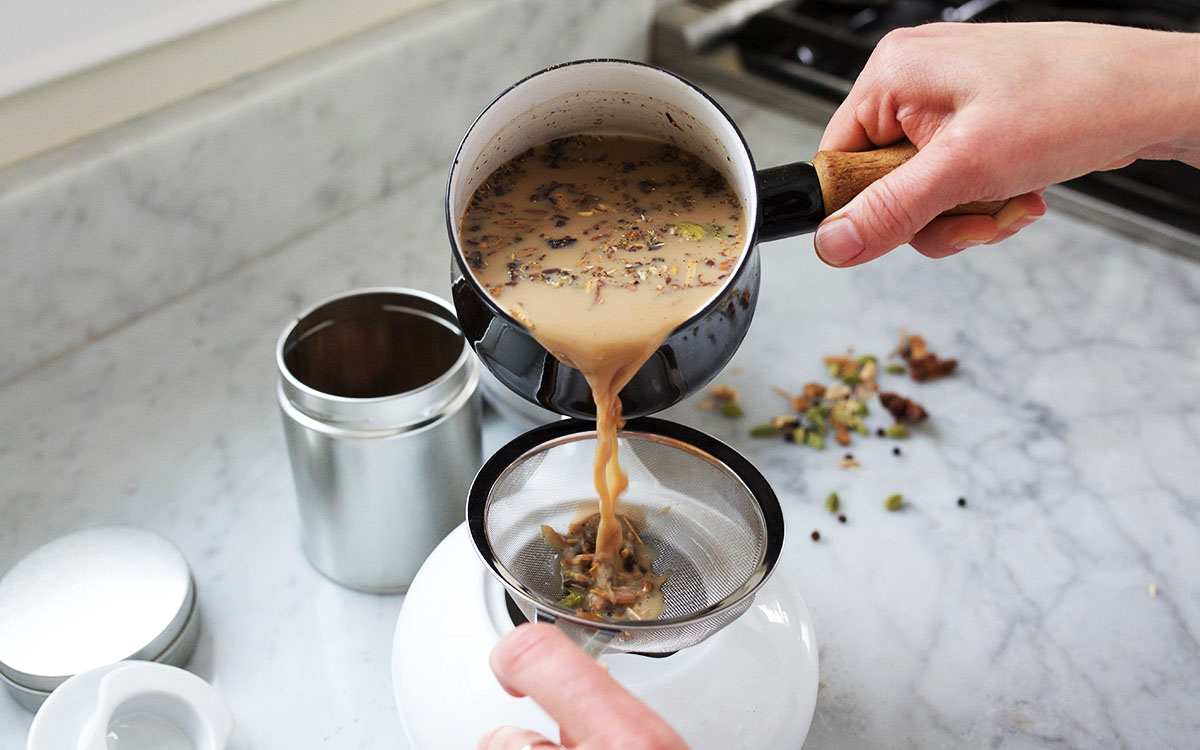
Cinnamon (Cinnamomum cassia)
Cinnamon is a well-known circulatory tonic and digestive aid. Its warm, sweet nature is particularly soothing for vata. It helps to dispel coldness in the extremities and enkindles agni, the digestive fire (Pole, 2013). Cinnamon has also been shown to have antibacterial and antifungal effects (Palanisamy, 2015).
Clove (Caryophyllus aromaticus)
Speaking of antimicrobials, clove is also excellent for fighting bacteria, fungus, and parasites (Palanisamy, 2015). Clove is also an analgesic, meaning that it can help reduce pain. It is particularly good at clearing congestion from the lungs, and its analgesic properties are well-known in the application of clove oil to treat a toothache (Pole, 2013). Due to its clearing and purifying nature, clove is particularly beneficial for kapha dosha.
Black Pepper (Piper nigrum)
Black pepper, with its hot nature and ability to stimulate digestion, is very useful for both vata and kapha. Black pepper is “useful for low appetite, sluggish digestion, abdominal pain, toxins…” (Pole, 2013). Black pepper also stimulates agni and circulation, having an overall warming effect on the body.
Overall, the chai spices are wonderful digestive aids, and as you can see, each spice also has additional benefits as well.
Now that we have covered the basic chai ingredients, let’s explore some recipes!
No matter how much of a kitchen maestro you may be, sometimes it helps to have a solid base recipe to use as a springboard. This recipe is shared courtesy of Athena Pappas, an accomplished Iyengar yoga teacher in San Francisco. I once overheard that she ‘made the best cup of chai in town,’ so when I started researching recipes for the perfect cup of chai, I knew her recipe had to be included. Here it is!
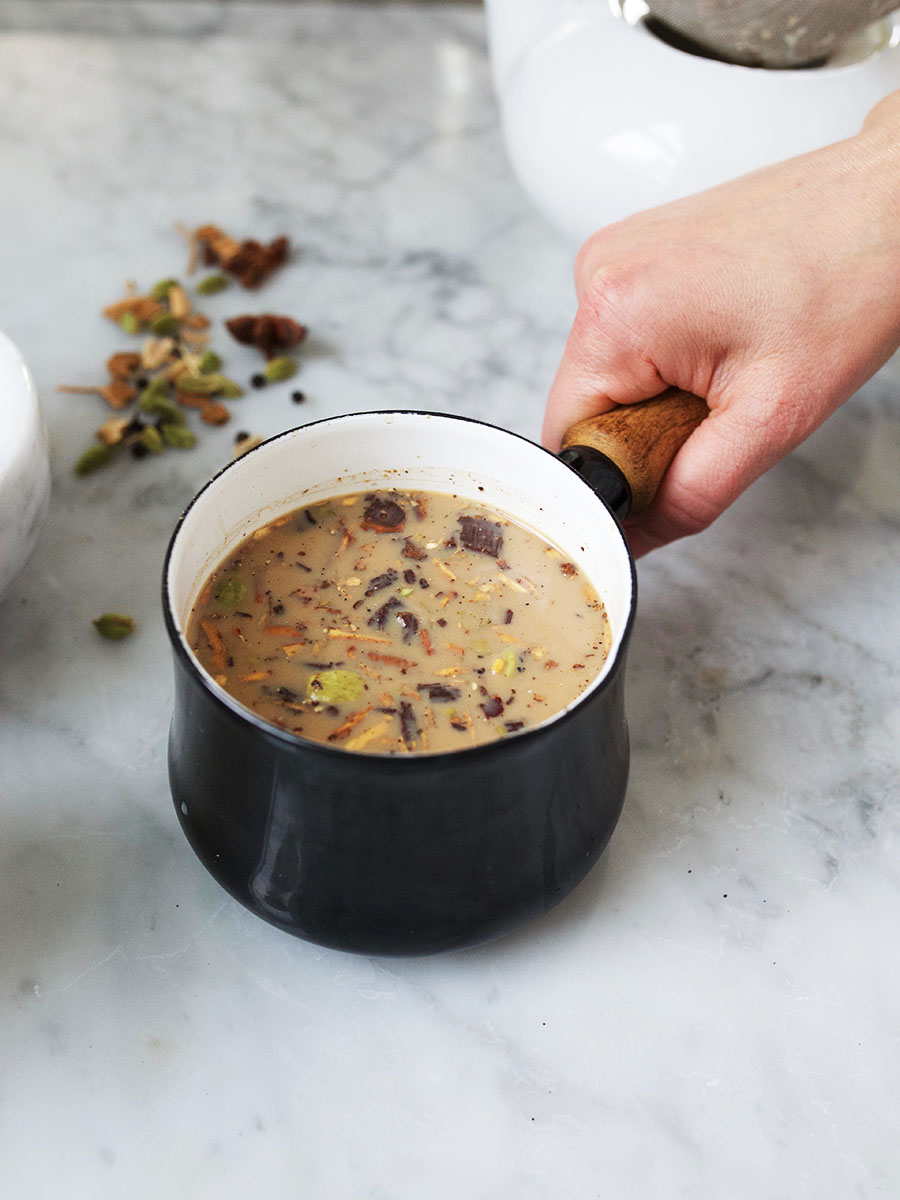
Spice measurements can be adapted to taste.
4 cups water As Athena notes in the recipe above, spice measurements can be altered to taste. Furthermore, I will add that the balance of the spices can alter the energetic qualities of your cup of tea, making it more or less suitable for your dosha. Here is a basic rundown of some alterations to fine tune this recipe to suit your dosha.
Ginger, cardamom, and cinnamon are particularly balancing to vata because they possess a combination of sweet and spicy tastes. Clove and black peppercorn are fine for vata, but as they are both quite pungent (meaning hot and/or purifying), it is best not to overdo these spices. Vata types may want to use the lesser amounts of these spices. For vata, you may also want to use a little less black tea, as vata types tend to have fragile and easily stimulated nervous systems. For a very sensitive vata, they could even forgo the tea entirely and turn this into a sweet, spiced milk.
Chai is overall warming in nature, which may aggravate pitta. However, the cool, sweet nature of the milk does help reduce the heat of the tea and spices. Also, since maple syrup is a little cooler than honey, pitta types may want to sweeten with maple syrup. Other ways to make a perfect cup of chai for pitta dosha are to decrease the cloves and black peppercorns and to add a teaspoon of fennel seeds. Fennel is cool, sweet, and pacifying to pitta dosha. Pittas can also add a splash of rosewater in their mug to finish, or a pinch of saffron to be really fancy. These ingredients have a very calming, cooling effect on pitta dosha.
Unlike vata and pitta, kaphas thrive with increased heat and stimulation. Kapha’s cool, heavy, slow nature benefits from hot spices. Kapha types can use the maximum amount of all the spices in this recipe and would be fine to use the full 3 tablespoons of black tea. Kapha would also do well to use a little less milk and honey, as those ingredients are both sweet, and thus increase kapha dosha. Milk, in particular, is a very kapha-increasing food. Almond milk would be a better choice, particularly for someone with a very strong kapha constitution or someone experiencing a head cold with excess mucus.
I tried out Athena’s recipe several times and found it to be aromatic, classic, and flavorful. Taking the time to simmer the tea and spices is well worth it as the simmering process really brings out the flavor of the spices, making this a fabulous, aromatic cup of chai tea. However, if you like to have chai first thing in the morning and don’t want to wait to simmer the spices, you can complete that part of the recipe in the evening. Simply let the spices steep in water overnight, and then finish the recipe by adding tea, milk, and honey in the morning.
The expert chai makers of AppalaChai agree with the importance of allowing for a long steep to truly bring out all the flavors of the tea and spices. AppalaChai is a small company that provides delicious, organic chai concentrate too many cafes and coffee shops throughout Western North Carolina and parts of South Carolina. This is what Tommy, co-founder of AppalaChai shared about their process:
“Currently, when we make our batches of concentrate we make sure we cook the spices long enough to extract as much from them as we possibly can. We then steep our black tea for some time before we add the sugar. All of our spices are organic as well as our black tea and evaporated cane sugar. Each batch is infused with “Maha Mantra” as well as some other rituals learned along the way including lots of love.”
Tommy’s explanation of AppalaChai’s process underscores the importance of taking time, using quality, organic ingredients, and of course the magic ingredient—love!
While time and love certainly pay off when it comes to chai alchemy, sometimes time is limited so I will share a few ‘cheater’ methods for chai preparation . These methods are great if you are pinched for time or lacking a few ingredients, and each shortcut will still yield a flavorful cup.
One shortcut is to keep a jar of ground tea masala spices on hand. Powdered tea masala blends can be purchased from Indian grocery stores or you can make your own.
Renowned Ayurvedic practitioner Dr. Vasant Lad gives a nice recipe for tea masala in his book, Ayurvedic Cooking for Self-Healing (2009), that is essentially a blend of ginger, cloves, black pepper, ground cinnamon, nutmeg, and cardamom (all in powdered form).
2 cups water Bring two cups of water to boil in a small saucepan. Add the black tea, then simmer for 2-3 minutes. Next, add a cup of milk and the tea masala powder. Turn the heat back on high. When the liquid starts to approach boiling, reduce the heat to low and simmer for 3 more minutes. Then turn off the heat, strain the tea into cups, and sweeten each with honey, maple syrup, or coconut sugar.
This is a quick and easy recipe that takes just a few minutes. You can also give this recipe a little extra kick by adding freshly grated ginger in the very beginning along with the water.
Although classic chai is truly my favorite, the classic Indian beverage offers loads of room for creativity, and there is ample opportunity to add additional herbs and spices to benefit your well-being.
Sometimes when I feel my vitality flagging, I like to add a teaspoon of a powdered adaptogenic herb such as ashwagandha. Ashwagandha (Withania somnifera) is very pacifying to vata dosha due to its sweet, warm energy and tonifying effects on the body and mind (Dass, 2013). Ashwagandha possesses the bitter and astringent tastes in addition to sweet, but I don’t generally notice the taste in my chai because the tea and masala spices mask it well. Ashwagandha is a highly revered rejuvenative herb in Ayurveda, and adding a bit to your chai can make it perfect for vata dosha.
Another chai tea variation is to add a tablespoon of freshly grated turmeric root for some extra blood-cleansing, anti-inflammatory benefits. To make it a turmeric chai, I recommend following Athena’s classic chai recipe and adding the fresh turmeric late in the game along with the tea. This method accents the earthy, fresh turmeric flavor.
For a truly magical and unique chai, I recommend visiting Alchemy in Asheville, North Carolina and having a cup of their turmeric chai. This cup of golden magic is the original creation of Emmy Bethel and can be ordered with or without black tea. I have enjoyed Alchemy’s turmeric chai on a number of occasions and had the honor of speaking to Emmy herself about this wonderful creation. I asked Emmy why she decided to add turmeric to a classic chai recipe and she explained that turmeric not only has powerful anti-inflammatory properties, but foods with the yellow color are also considered to be spleen-stomach tonics in Traditional Chinese Medicine.
Emmy explained that this special chai recipe is deeply nourishing and meant to tone and nourish the spleen-stomach, which is similar to the concept of agni (digestive fire) in Ayurveda. Emmy did much experimenting and refining in order to get this recipe just right, and Alchemy currently uses dried turmeric root powder as well as turmeric and black pepper extract for this very special recipe. The team at Alchemy also adds a special South American root called yacon, which has prebiotic benefits, meaning that it feeds the good gut bacteria.
Lastly, chicory root makes a great black tea substitute for those who are avoiding caffeine. Chicory granules can be purchased in bulk from various herb suppliers and health food stores. Chicory has a rich, roasted flavor similar to coffee, but it is, in fact, a cooling blood and liver cleanser. Chicory is an especially nice option for pitta types who tend to get cranky livers and problems related to excess heat and metabolic wastes in the blood. It is also a good option for vata types, who may find black tea to be overly drying and stimulating.
As you can see, there is more than one way to make a perfect cup of chai tea. One of the beautiful things about chai is that once you have the basic ingredients on hand, it is fairly simple, and as long as you don’t stray too far from the basics, it’s hard to go wrong!
I hope that this article has given you a sense of how you can play with spices and herbs in order to suit your cup to your tastes and Ayurvedic dosha. You may also find that your perfect cup of chai tea changes from one season to the next, emphasizing warmer spices in cooler months and accenting the cool spices in the hot time of year. All you need is a handful of quality ingredients and a few moments to spare—a warming, healthful hot cup of spicy tea is not far away. REFERENCES
Dass, V. (2013). Ayurvedic herbology. Twin Lakes, WI: Lotus Press.
Lad, U., & Lad, V. (2009). Ayurvedic cooking for self-healing. Albuquerque, NM: The Ayurvedic Press.
Palanisamy, A. (2015). The paleovedic diet. New York, NY: Skyhorse Publishing.
Pole, S. (2013). Ayurvedic medicine: The principles of traditional practice. London: Singing Dragon.
Athena Pappas' Chai Tea
1 tablespoon grated ginger
10-12 green cardamom pods
2 black cardamom pods
8-10 cloves
12-15 black peppercorns
⅛ stick cinnamon
2 -3 tablespoons strong black tea, such as assam or ceylon
The Perfect Cup of Chai for Your Dosha
Chai for Vata
Chai for Pitta
Chai for Kapha
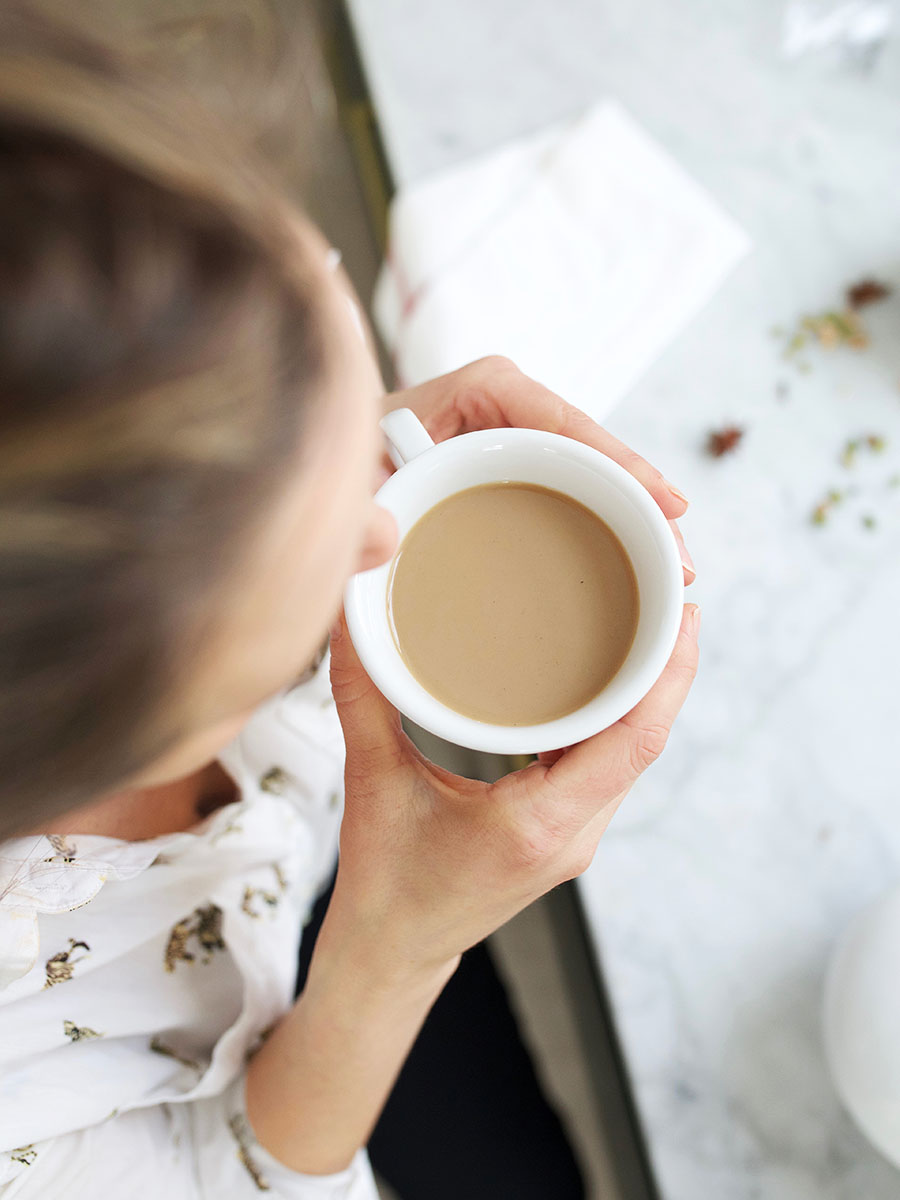
It’s All About The Steep Time
Chai Shortcuts
Powdered Chai Tea Masala
1 cup whole cow’s milk (can substitute with any fatty milk)
1-2 tablespoons black tea leaves
1-2 teaspoons tea masala

Additional Chai Variations
Final Thoughts
